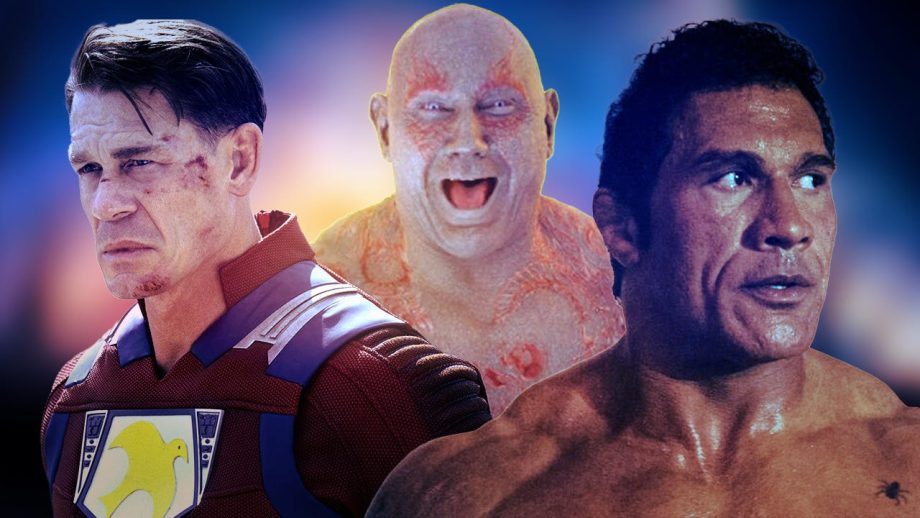John Cena, Dave Bautista, and Dwayne “The Rock” Johnson are the holy trinity of wrestlers-turned-actors, breaking through to the larger culture and stomping mudholes in the box office. Other wrestlers are landing prominent roles in shows and movies, but none have reached the same heights of mainstream megapower.
Why did these specific superstars emerge from the acting undercard and become major draws? How did they shatter the sports entertainment stigma? And what lessons could an aspiring in-ring thespian learn from their careers?
Suppose you’re a hard-working pro-wrestler who’s tired of making towns and taking bumps, and you’re eager to swap the sweaty canvas mat for a swanky red carpet. Lesson 1: Don’t be too quick to hang up your boots. Hollywood is where the big boys play, but in wrestling, it helps to be the Man.
1. Be “The Man”
The Rock, Batista, and Cena were all “top guys” in their respective eras before jumping to Hollywood. With tons of world championships, pay-per-view main events, and truckloads of questionable merch between them, each had reached the pinnacle of pro wrestling popularity before taking their talents to L.A. You’re unlikely to see a curtain-jerking “jobber” hosting SNL or changing the hierarchy of power in the DC Universe. Wrestling star power gives you a massive head start.
Name recognition obviously plays a huge part, but there’s more to it than that. Call it what you will: aura, rizz, electricity – if there’s an “it” factor, these folks have it. Whether it’s wrestling, acting, music, or anything else, if you’re successful in one medium, you’ve got a big leg up in another.
Before pro wrestling went corporate, a wrestler’s worth was measured in their ability to “draw money,” AKA selling tickets that put butts in seats all around the world. Movies aren’t much different, and not just in Hollywood. The legendary El Santo and his fellow luchadores starred in dozens upon dozens of Mexican action films in the ‘60s and ‘70s. Their in-ring fame and the undeniable drip of masked men in wide-lapel suits transformed them into cinema superheroes.
Status-obsessed Hollywood took a little longer to embrace the inherently carny heritage of pro wrestlers, but times have changed. A bankable star’s face on a poster once all but guaranteed boffo box office, and now that the monoculture has just about tapped out, studios are looking for established, big-name talents – and the followers they bring with them.
You don’t need to be a first-ballot Hall of Famer to have a great career in the movies – workers lower on the marquee have carved out awesome careers for themselves. The likes of Roddy Piper and Jesse Ventura worked with skilled and respected cult filmmakers throughout the ‘80s, and countless wrestlers have become immortalized through minor roles and iconic cameos over the decades.
Pre-existing popularity is a huge help, but it’s no guarantee. “Stone Cold” Steve Austin was arguably the most popular and lucrative pro wrestler ever, and his film career fizzled out after a couple of half-hearted attempts. “The Texas Rattlesnake” was an ill fit for acting, but he eventually found his true passion: shouting encouragement at young people doing obstacle courses in his backyard.
Austin wasn’t even the biggest Hollywood bag fumble. That honor goes to the late Hulk Hogan. The Hulkster was the biggest star of one boom period and a major player in another, but one huge misstep early in his career K.O.’ed his acting ambitions like Sweet Chin Music to the dome. Hogan could have had it all, but he stuck too close to wrestling. Which brings us to our second piece of advice: Don’t be afraid to run wild.
2. Run Wild
The rise of Hulkamania couldn’t have happened without Hollywood. Hogan’s ascent began with his pre-WWE role as “Thunderlips” in Rocky III, which inspired WWE owner Vince McMahon to poach the Hulkster and make him the face of a Rock N’ Wrestling revolution. Soon, Hogan was saying prayers and taking vitamins alongside ‘80s pop icons like Cyndi Lauper, Mr. T, and Richard Belzer. It seemed only a matter of time before he dropped the leg on the movie business, leaving WWE in the dust.
Afraid of losing his biggest draw, McMahon took matters into his own hands. Rather than risk losing control of his top attraction, McMahon would fund his own blockbuster movie and convince Hogan to star with a juicy executive producer credit. The Hulkster accepted, and the two set off to write a film that would launch Hogan’s acting career.
What kind of razor-sharp screenplay would emerge from the minds that brought us the “Kiss My Ass Club” and the “Dungeon of Doom?” What kino would they conceive to cement Hulk Hogan as the next Schwarzenegger or Stallone?
No Holds Barred.
The film was a fiasco, one of cinema’s infamous disasters. Countless bad movie podcasts have spilled innumerable riffs upon its badness, which can be summed up in one word: “Dookie.” As a debut, it couldn’t have really gone much worse.
No Holds Barred had the stink of wrestling all over it. It’s about wrestling, Hulk Hogan plays a barely fictionalized version of his in-ring character, and McMahon’s scatalogical sense of humor is rampant throughout. It’s 93 minutes of insulting sleaze. Today’s corporate, post-Vince WWE displays the broad, relatively safe, and wildly successful appeal of Marvel and Disney, but back then there was still an air of dirtbaggery around the business from which the film could not escape.
It was shilled relentlessly on WWF programming without much success, culminating in a desperate pay-per-view cage match between Hogan and his on-screen nemesis, Zeus “Tiny” Lister, that didn’t even do very well. No Holds Barred is a terrible, oftentimes revolting film. It soured the audience on the grand experiment of wrestlers-turned-actors for a long time – and put an end to Hogan’s Hollywood dreams.






